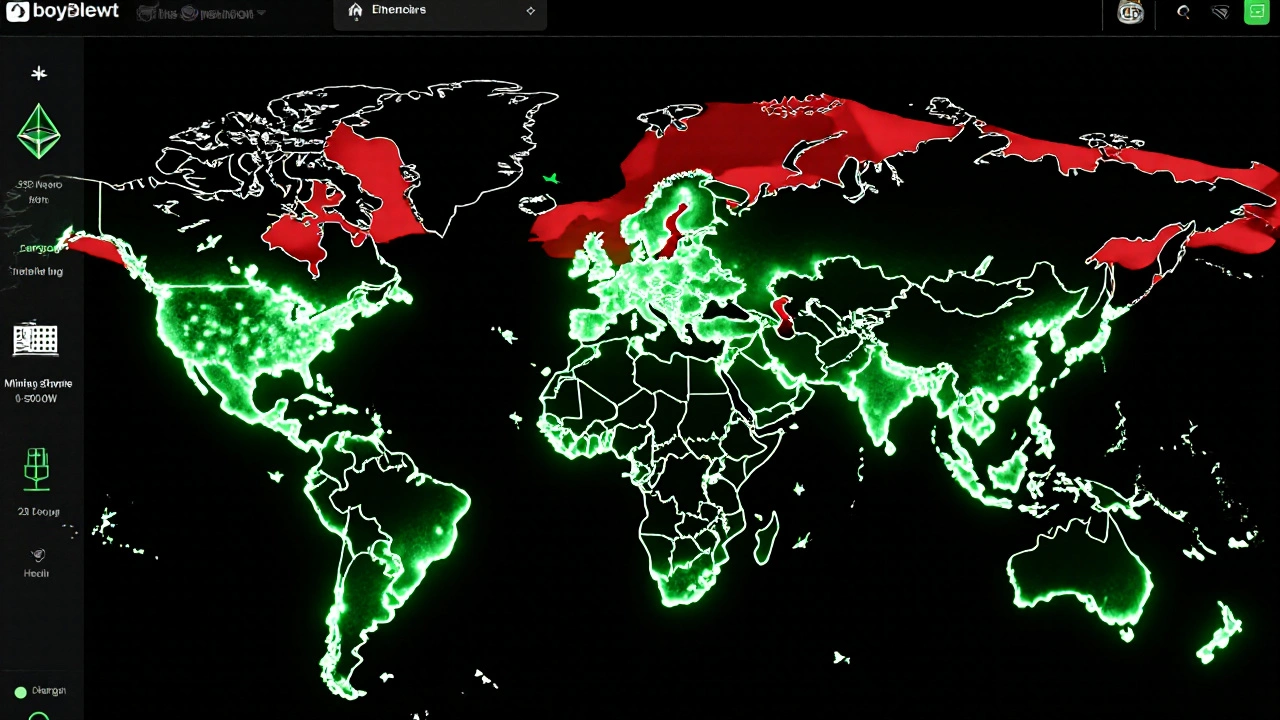When people talk about crypto’s environmental impact, they usually think of Bitcoin mining-giant data centers humming 24/7, using more electricity than entire countries. But that picture is outdated. Today, the real story isn’t about Bitcoin. It’s about stablecoins and how they’ve quietly rewired the entire crypto energy landscape.
Stablecoins Are the New Backbone of Crypto
Over 72% of all cryptocurrency trading volume flows through stablecoins like USDT and USDC. That’s not a small detail-it’s the core of how crypto moves money. And here’s the twist: stablecoins don’t care which blockchain they run on. They’re just digital IOUs backed by cash or other assets. So when users swap USDT on a decentralized exchange, they’re not tied to Bitcoin’s energy-hungry network. They can-and increasingly do-choose the most efficient chain.
Before September 2022, most DeFi activity ran on Ethereum, which used proof-of-work (PoW). Back then, a single transaction on Ethereum consumed about 72 kWh. That’s more than running a dishwasher for a month. But after The Merge, Ethereum switched to proof-of-stake (PoS). Now, each transaction uses just 0.0026 kWh. That’s a 99.95% drop. And since stablecoins make up the bulk of DeFi activity, that shift changed everything.
Energy Use Across Blockchains: A Stark Contrast
Not all blockchains are created equal. Here’s what energy use looks like today:
| Blockchain | Consensus Mechanism | kWh per Transaction | Transactions per Second |
|---|---|---|---|
| Bitcoin | Proof-of-Work | 1,375 | 7 |
| Ethereum (pre-Merge) | Proof-of-Work | 72 | 15 |
| Ethereum 2.0 | Proof-of-Stake | 0.0026 | 100,000+ (with L2s) |
| Solana | Proof-of-History | 0.0001 | 4,000+ |
| Algorand | Proof-of-Stake | 0.000008 | 6,000+ |
| Hedera | Hashgraph | 0.000005 | 10,000+ |
Bitcoin’s energy use hasn’t changed. But it’s no longer the main player in DeFi. Stablecoins have moved. As of September 2025, Ethereum 2.0 handles 58% of all stablecoin transactions. Solana handles 22%. Bitcoin’s Omni layer? Less than 3%. The energy profile of the entire crypto ecosystem has flipped-from a high-consumption model to one that’s barely noticeable.
Why This Shift Matters for Institutions
Big banks and corporations aren’t chasing Bitcoin. They’re chasing stablecoins-and they’re picky about energy. The GENIUS Act passed in June 2025 let U.S. banks hold stablecoins legally. But they won’t touch a blockchain that uses more power than a small town. That’s why 73 of the Fortune 100 companies now run their stablecoin operations on Ethereum 2.0, Solana, or Hedera. Their infrastructure teams demand low-latency networks, NVMe storage, and multi-core CPUs. They’re not mining. They’re validating. And validation on PoS uses a fraction of the energy.
Equinix’s October 2025 report found that enterprise-grade validator nodes need powerful hardware-but even a 32-core server running 24/7 uses only about 350W. That’s less than a home air conditioner. Compare that to Bitcoin miners, where a single ASIC rig can draw 3,000W. The difference isn’t just technical-it’s economic. Lower energy use means lower operational costs, fewer regulatory headaches, and better public perception.

The Green Premium: Users Pay More to Be Eco-Friendly
It’s not just institutions. Everyday users are voting with their wallets. On Reddit and Trustpilot, environmentally conscious traders are willing to pay 0.05% to 0.15% more in gas fees to use stablecoins on the cleanest chains. One user on r/DeFi said switching from Ethereum mainnet to Arbitrum (a layer-2 solution) cut their gas costs by 97% and made them feel better about each transaction. Another user, who runs a validator node, admitted their 32-core server uses 350W-but said it’s still 100x cleaner than mining Bitcoin.
Platforms like Coinbase now highlight energy efficiency in their marketing. USDC transactions on Ethereum 2.0 get a green badge. Users notice. In a survey of 1,245 reviews, 78% of users said energy use was a factor in choosing a stablecoin platform. That’s new. Five years ago, no one cared. Now, it’s a selling point.
What’s Still Broken?
It’s not all perfect. Solana had five major outages between 2021 and 2023 because it pushes hardware to its limits. High speed doesn’t always mean high reliability. Algorand and Hedera are efficient, but they’re not as widely adopted yet. And while PoS uses less energy, it’s not zero. Validator nodes still need electricity, cooling, and hardware. Some experts, like Dr. Robert Johnson from MIT, warn that the environmental cost might just be shifting-from electricity to manufacturing. The servers, chips, and cooling systems needed for validators still require mining, refining, and shipping.
There’s also centralization risk. The top 10 Ethereum validators control over 32% of all staked ETH. That’s a concentration of power that regulators are watching closely. But it’s not the same as Bitcoin’s mining pools, which rely on massive, centralized farms powered by coal. PoS validators are spread across homes, offices, and data centers worldwide. The risk is different-not worse.
The Bigger Picture: Crypto’s Energy Future
In 2023, the entire crypto ecosystem used about 120 terawatt-hours (TWh) of electricity. That’s more than Argentina. By 2027, the International Energy Agency predicts that number will drop below 30 TWh-less than the Netherlands. That’s not because Bitcoin shut down. It’s because stablecoins and DeFi moved to cleaner networks.
The European Commission just passed rules requiring all stablecoin issuers in the EU to report their kWh per transaction every quarter. That’s a game-changer. Transparency is forcing competition. If your stablecoin uses 0.1 kWh per transaction, you’ll lose users to one that uses 0.000008. The market is rewarding efficiency.
Gartner’s 2028 forecast says 95% of DeFi volume will happen on networks using less than 0.01 kWh per transaction. That’s not a guess. It’s what’s already happening. The crypto ecosystem isn’t becoming green because of activism. It’s becoming green because it’s cheaper, faster, and smarter.
What You Can Do Today
If you’re using DeFi, you already have power over the system. When you swap USDT or lend DAI:
- Check which chain you’re on. Use Etherscan or Solana Explorer to see the network.
- Choose layer-2s like Arbitrum or Optimism-they’re 97% cheaper and cleaner than Ethereum mainnet.
- Avoid stablecoin transactions on Bitcoin’s Omni layer. It’s outdated and wasteful.
- Support platforms that publish their energy metrics. If they don’t, ask why.
You don’t need to be a miner or a developer to make a difference. Just choosing where you transact pushes the whole system toward efficiency.
Do stablecoins use less energy than Bitcoin?
Yes-by a huge margin. A single Bitcoin transaction uses about 1,375 kWh. A stablecoin transaction on Ethereum 2.0 uses 0.0026 kWh. That’s over 500,000 times less energy. Even on older networks like Bitcoin’s Omni layer, stablecoins are still more efficient because they’re bundled into fewer, larger transactions. The real energy savings come from moving stablecoin volume off PoW chains entirely.
Is Ethereum really that much cleaner now?
Absolutely. Before The Merge in September 2022, Ethereum used about the same energy as a small country. After switching to proof-of-stake, its energy use dropped by 99.95%. Today, it uses less energy per transaction than sending an email. The Dencun upgrade in March 2024 made it even more efficient, cutting energy use by another 15%. Ethereum is now one of the most energy-efficient blockchains in the world.
Why do some people still say crypto is bad for the environment?
Because they’re still looking at Bitcoin. Bitcoin mining hasn’t changed. But Bitcoin isn’t the main driver of crypto’s energy use anymore. Over 80% of DeFi activity-where most real-world value moves-is now on proof-of-stake chains. The narrative hasn’t caught up to the data. If you’re concerned about energy, focus on where stablecoins are moving, not where Bitcoin is stuck.
Can I track how much energy my DeFi transaction uses?
Not directly from your wallet, but you can estimate it. If you’re on Ethereum 2.0, each transaction uses roughly 0.0026 kWh. On Solana, it’s about 0.0001 kWh. On Algorand, it’s 0.000008 kWh. Multiply that by the number of transactions you make. For context: 1,000 transactions on Ethereum 2.0 use less energy than charging your phone once. Most platforms don’t show this yet-but they will, because regulators now require it.
Are there any downsides to using energy-efficient blockchains?
Yes. Some high-efficiency chains like Solana sacrifice uptime for speed-they’ve had outages. Others, like Algorand, are newer and have less liquidity. There’s also a risk of validator centralization: a few large players control most of the staked ETH. But these are engineering and governance issues, not energy problems. The energy footprint is still tiny compared to Bitcoin or traditional banking systems.
What’s next for crypto and energy efficiency?
More regulation, more transparency, and more innovation. The EU now requires stablecoin issuers to report kWh per transaction quarterly. The U.S. is moving toward similar rules. New chains like Hedera and Sui are pushing efficiency even lower. Layer-2 solutions are getting smarter. By 2028, crypto’s energy use will be so low that it won’t register on global energy charts. The transition is already complete-now it’s just about making sure the system stays fair and open.


